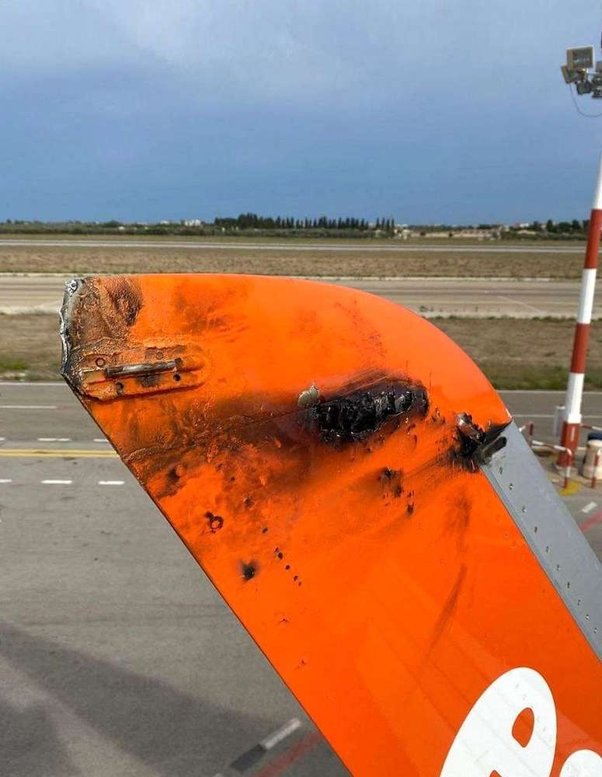
Like many things in aviation, the development of composite materials used in aviation is a long and interesting development. Aluminum with its excellent electrical conductivity, is well able to cope with lightning. As more composite material with poor or little conductivity is used in aircraft construction, electrical shielding, radio wave grounding and lightning protection has become an increasingly important part of aircraft design and maintenance.
A lot of testing has always gone on in respect of aircraft coping with lightning and has resulted in high safety despite the frequent strikes on all IFR aircraft. An example – lab testing of a radome getting lightning strikes. Radomes basically used the first composites in aviation. Composites like fiberglass let the radar signals pass through, but provide necessary structure.
This testing, like this R & D lab lightning, is so airplanes survive lightning strikes. Like this.
This research has been going on really, ever since “fiberglass” families of plastics have been used in aircraft construction for their light weight and strength. The problems of conductivity and static electricity have been solved in two ways.
The first solution has been to embed wire mesh into the construction, and so provide radio “grounding”. And this must be sufficient to pass lightning currents. Added mesh was successfully used in an early but now obsolete composite aircraft, the Beechcraft Starship, for radio and lightning purposes.
The second has to do with a further problem – static electricity. This comes from the rushing air over the surface generating huge static charges. Static electricity generated from air/rain/snow rubbing the paint, sparks through the paint to the metal beneath and so to the wing static dischargers. Note, these same wing dischargers are also designed to handle lightning strike/discharge.
But lightning is an infrequent discharge of static electricity. And static electricity is a constant problem with aircraft, it’s just at lower intensities. The wind and rain rushing over the aircraft surfaces generate huge amounts of static electricity, and without attention will completely disable communication and navigation. In aluminum aircraft the static electricity easily jumps through the paint to the metal beneath and then safely to the wing dischargers.
Composite surfaces, have no such metal near to spark into and be safely discharged. This problem is solved by making the paint slightly conductive. Radomes 50 years ago were painted black with carbon black and linseed oil. Now, we have static conductive paints. Again, lightning is special and dangerous. To control lightning strikes on composite surfaces like nose radomes, a trick is used. Strips of conductor are made as strips of small isolated dots.
The aircraft radar is mounted in the nose to see the weather ahead. The microwave radar beams happily pass through these special strips. And lightning happily hops along the metal dots to reach the aluminum body.
In the last few decades, with just a few panels and structures (like flaps) made of composite on high altitude aircraft, lightning protection has not been an issue. But now with larger and even complete new aircraft structures being composite and not aluminum, the lightning issue has been further attended to. The small conductivity of the composite substrates introduced in aircraft construction, though fine for radio noise control, and safe operations of communications, navigation and control avionics, is inadequate for lightning surges. It is necessary to create a path for the lightning and its terrible high currents.
Quite a few solutions have been developed according to the specifics of risk and materials requirement. From simply adding conductive copper mesh to the structure, to embedding various conductive materials into the composite needs of a particular part of the aircraft. In the end, design used for aircraft must be sufficient to manage the lightning strike level currents of hundreds of amperes, and as before, deliver the currents safely to dischargers.
An exiting new material has entered engineering. Graphene is a remarkable and new carbon material. It is the strongest material ever made and is bound to be used in making aircraft. Graphene is carbon sheeting only one molecule thick. It is made into tubes for structural use and spheres for molecular level storage (Buckyballs or C60). It’ll be interesting as this new form of carbon gets into aircraft construction. Because not only is it incredibly strong, it is an excellent conductor.
Author – Jock McTavish


